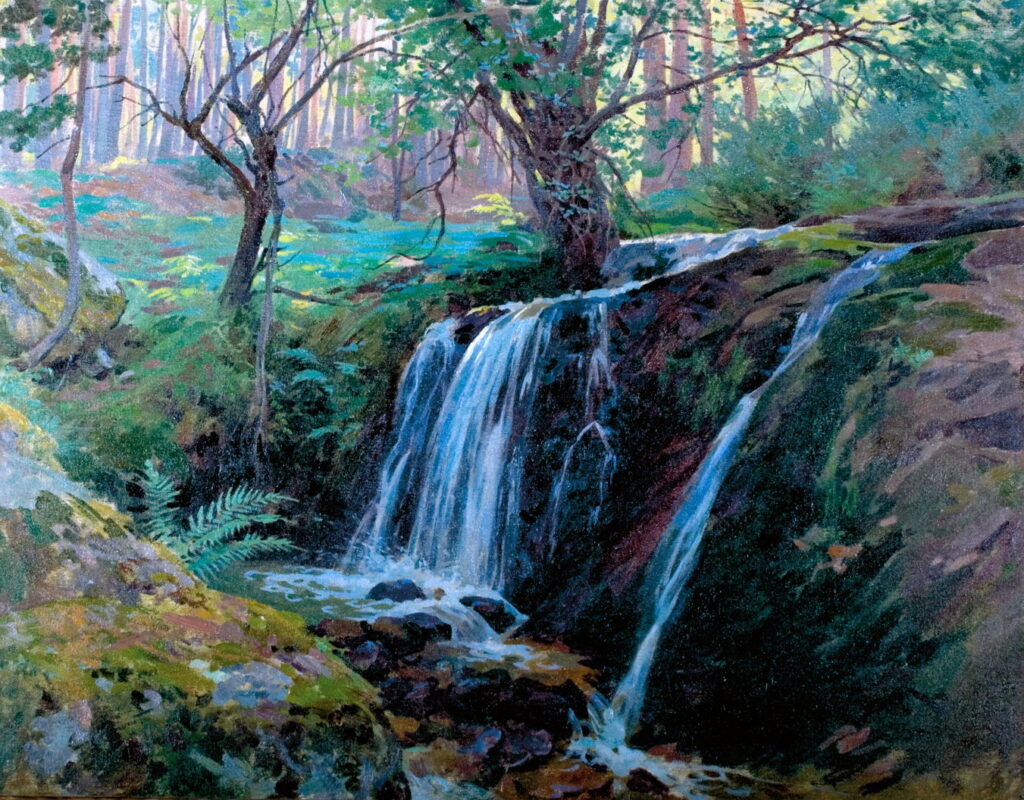Landscapes of Spain: The twentieth century

From the opening to the public of the Museo Nacional del Prado in November 1819, it has drawn a steady succession of aspiring painters to Madrid to study the works of Hieronymus Bosch, El Greco, Peter Paul Rubens, Titian, Diego Velázquez, Francisco Goya, and others. This weekend I show a small selection of landscape paintings made of the interior of Spain by visitors and natives, and in this second article have reached the start of the twentieth century.
John Ferguson Weir (1841-1926), The Alhambra, Granada, Spain (c 1901), oil on canvas, 92.1 x 118.1 cm, The Metropolitan Museum of Art (Gift of David T. Owsley, 1964), New York, NY. Courtesy of The Metropolitan Museum of Art.
The founder of the School of Fine Arts at Yale University, John Ferguson Weir, had studied in Europe, and his brother Julian Alden Weir was a student at the École des Beaux-Arts in Paris. Later in his career, John Ferguson Weir returned to Europe on several trips, and in about 1901 painted this fine view of The Alhambra, Granada, Spain.
Laurits Tuxen (1853–1927), View of the Alhambra (1902), oil on canvas, 54 x 72 cm, location not known. Wikimedia Commons.
As far as I can tell, Laurits Tuxen was the first Danish artist to paint a View of the Alhambra. He did so in 1902, the year after marrying his second wife. He was one of the leading members of the Skagen painters, Nordic Impressionists, and completed this en plein air on 4 May, in wonderfully fine weather.
James Dickson Innes (1887-1914), Spanish Landscape (1912), oil on wood panel, 32.7 x 40.6 cm, Art Gallery of South Australia, Adelaide, Australia. Wikimedia Commons.
James Dickson Innes, a painter from Wales who was a member of the Camden Town Group, visited Spain in 1912-13, where he painted this Spanish Landscape in oils on a wood panel.
James Dickson Innes (1887-1914), Deep Twilight, Pyrenees (1912-13), oil on panel, 22.2 x 31.8 cm, Yale Center for British Art, New Haven, CT. Wikimedia Commons.
Innes had a particular affection for dusk, as seen in his Deep Twilight, Pyrenees, painted in 1912-13.
Antonio Muñoz Degrain (1840-1924), View of the Alhambra (1914), oil on canvas, 125 x 83 cm, Museo de Málaga. Wikimedia Commons.
Muñoz Degrain’s view of the Alhambra from Albaicin District is remarkable for the rhythm established by the poplar trees around its base, which become an integral part of the fortified ridge.
Antonio Muñoz Degrain (1840-1924), View of the Alhambra (date not known), further details not known. Wikimedia Commons.
His View of the Alhambra is one of my favourite paintings of this motif, for its intriguing foreground details, and the poplars lit as white-hot pokers in the fiery light of sunset.
Joaquín Sorolla y Bastida (1863–1923), Albaicin (date not known), further details not known. Wikimedia Commons.
Joaquín Sorolla, best known for his figurative works, also painted fine landscapes. This undated view of Albaicin looks down from one of the Alhambra’s towers at the bleached white buildings below.
Joaquín Sorolla y Bastida (1863–1923), Sierra Nevada, Granada (1917), oil on canvas, 64.8 x 95.3 cm, Private collection. WikiArt.
In 1917, when he was exhausted after completing fourteen large murals for the Hispanic Society of America building in Manhattan, Sorolla recovered by painting landscapes. In his Sierra Nevada, Granada, the mountains dominate, with patches of cloud adding uncertainty to their forms.
Enrique Simonet Lombardo (1866–1927), Otoño en la Dehesa (Autumn in the Dehesa) (1918), oil on canvas, 58 x 43 cm, location not known. Wikimedia Commons.
This canvas by the Spanish artist Enrique Simonet shows a thoroughly Spanish motif: Autumn in the Dehesa, a type of landscape characteristic of southern and central Spain and Portugal, where it’s known as montado. This is a traditional mixed, multifunctional environment providing grazing for cattle, goats, sheep and pigs, mixed trees centred on oaks, and support for many endangered species such as the Iberian lynx and Spanish imperial eagle.
Enrique Simonet Lombardo (1866–1927), La Moncloa Landscape (1918-20), oil on canvas, 47 x 56 cm, location not known. Wikimedia Commons.
Simonet’s La Moncloa Landscape from 1918-20 shows another rural area, with its ancient woodland and open plains. There may also be a pun intended, as the term La Moncloa can be used to refer to the central government of Spain.
Enrique Simonet Lombardo (1866–1927), Reflections on the River (1918-23), oil on canvas, 62 x 44 cm, location not known. Wikimedia Commons.
Most of Simonet’s later paintings, such as Reflections on the River (1918-23), are pure landscapes.
Enrique Simonet Lombardo (1866–1927), El Paular Landscape (1921), oil on canvas, 62 x 78 cm, location not known. Wikimedia Commons.
During 1921-22, Simonet was director of landscape painting courses held in El Paular, to the north-west of Madrid. There he painted some of the finest of these late works, such as his El Paular Landscape from 1921.
Enrique Simonet Lombardo (1866–1927), Hiruela Waterfall (1921-23), oil on canvas, 70 x 90 cm, location not known. Wikimedia Commons.
His Hiruela Waterfall (1921-23) is set in dense woodland to the north of Madrid.
Torajirō Kojima 児島虎次郎 (1881–1929), Landscape in Spain スペインの風景 (1920), oil on canvas, 57.5 x 70 cm, Ōhara Museum of Art 大原美術館, Kurashiki, Japan. Wikimedia Commons.
Around 1920, the Japanese artist Torajirō Kojima appears to have visited Spain, where he painted the Alhambra, and this wonderful view of a mountainous Landscape in Spain スペインの風景.
Sir William Nicholson (1872–1949), Plaza de Toros, Malaga (1935), oil on plywood, 64.8 x 77.7 cm, The Tate Gallery (Presented by Miss H. Stocks 1989), London. © The Tate Gallery and Photographic Rights © Tate (2016), CC-BY-NC-ND 3.0 (Unported), https://www.tate.org.uk/art/artworks/nicholson-plaza-de-toros-malaga-t05520
Late in his distinguished career, when he was teaching Winston Churchill to paint, the British painter, print-maker and illustrator Sir William Nicholson travelled to Andalucia in Spain. There he met the novelist Marguerite Steen (1894-1975), and she became his companion for the remaining fifteen years of his life. She had a passion for bullfights, and Nicholson found himself working up a study of the Plaza de Toros, Malaga into a major painting. This finished version shows his distinctive use of colour as a result of the intense light in southern Spain. This was exhibited in London the following year.
La Malagueta, as this bull ring is known, was a lifelong inspiration for Pablo Picasso (1881-1973), who was born and brought up in the city. Unlike Picasso, though, Nicholson’s interest was more distant, in the bullring’s form and position, rather than the thrill and spectacle of bullfights.



